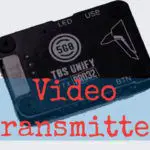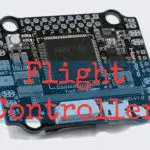An FPV antenna is one of the most basic components of your FPV drone. Without it, your drone is just a normal drone, and not an FPV drone. Getting the right FPV antenna is therefore crucial for any FPV drone builds. In this guide, I’ll teach you how to choose the best antenna for your FPV drones.
For best signals, use 5.8 GHz CP antennas in your FPV system. Mount omni antennas on your drone, and both directional and omni antennas on your FPV goggles. Use either RH or LH, but not both! Make sure the antenna connectors fit the VTX/VRX ports. If you need to shed weights, use LP antennas with U.FL connector on the drone.
The quality of the antenna decides the range and signal strength of your FPV system. So, let’s drill in a little bit further on how antennas work and what are the other things to look at when choosing antennas for your FPV drone.

What is FPV Antenna
All radio equipment requires an antenna to work. In case you are not aware of it, your smart phone also has more than 1 antenna hidden within.
An FPV antenna is a component used to convert electrical video signals to radio signals and radiates the signal. It also receives radio signals in the air, and converts them back to electrical video signals. FPV antennas are installed on both the FPV video transmitter and video receiver. Without antennas, both VTX and VRX cannot work properly.

An antenna can be divided into 3 sections: the active element, coaxial cable and connector. The active element is the key component to transmit and receive radio; a connector is crucial to connect your VTX or VRX; while the coaxial cable simply joins both 2 together.
Antenna Polarization
Every FPV antenna has its own polarization, which can be classified into 2 groups: the linear and the circular polarization.
In linear polarization or LP, an antenna transmits a radio wave that travels in a vertical or horizontal orientation as it moves forward. Common linear polarized antennas are monopole, dipole and patched antenna.
If the radio wave transmitted by an antenna rotates as it travels, the antenna is considered circular polarized, or CP. The rotation can be clockwise (right-handed, RH) or counter clockwise (left-handed, LH). A circular polarized antenna has either a skew planar wheel, cloverleaf, pagoda, helical, and even patch design.
Linear polarized antennas provide the best signal if the antennas on both VTX and VRX are aligned. This means both antennas must be oriented vertically (or horizontally). When both the antennas are perpendicular to each other, the signal loss is huge.
Because the orientation of drones are constantly changing in flight, there is always misalignment between the antenna on the VTX and VRX. Moreover, LP antennas are susceptible to multipathing (more on this at the end of this guide).
Hence, while theoretically LP antennas are good for long range, it is not as popular in FPV racing drones. However, if you have antenna diversity on your FPV goggles (which means you can mount 2 antennas), you can use 2 LP antennas set perpendicular to each other on your goggle to reduce the signal loss from using linear polarized antennas, or use an LP and a CP antenna.
On the other hand, circular polarized antennas on VTX and VRX don’t have significant alignment issues when the drone is flying at different orientations. Moreover, it is resistant to multipathing. This makes the circular polarized antenna an excellent choice for FPV drones.
Can I Mix LP and CP Antenna in My FPV System?
Yes, you can definitely use an LP antenna on your VTX and a CP antenna on your VRX.
The reason why people do this is to reduce the weight of their drones, especially if they are flying mini whoops, since LP antennas are lightweight. You can save up to 10 g or more when using an LP antenna!
Do note that there will be a significant reduction in signal strength when mixing antennas. Having said that, the signal strength from mixed antennas is still higher than using LP antennas alone.
If you are flying 5″, you can just stick with a circular polarized antenna on your VTX since its weight is not significant compared with the weight of your drone.
Can I Mix LHCP and RHCP Antenna?
No, you shouldn’t mix LH and RH circular polarized antennas in your setup because they tend to reject each other. You will experience a huge loss in signal if you mix them.
One thing worth noting is that both RH and LH antennas have minimum interference with each other since they are rejecting each other. You will experience the least interference when flying in a group if you use CP antennas with different orientation from other drones.
Directional vs Omnidirectional Antenna

A directional antenna focuses all the energy to transmit signals at 1 direction. Hence, the signal strength is stronger. Because it works best in a certain direction, it is not suitable for FPV drones. Remember, your FPV drone keeps on turning around and it is not possible to get the antenna pointed towards you.
In contrast, the omnidirectional antennas transmit signal in all directions. While the signal strength becomes weaker, it is consistent regardless of direction.
A great analogy would be comparing torch light and light bulb. A torch light is directional, which focuses the light towards 1 direction. In contrast, a light bulb is omnidirectional, and the light is spread out towards all directions.
For the purpose of FPV drones, you should use omnidirectional antennas on your VTX because you can’t always make your drone position the antenna towards you. Meanwhile, your VRX can be fitted with a directional antenna for better signal receiving.
If you have antenna diversity on your FPV goggles, you can use both directional and omnidirectional antennas to make up each other’s weaknesses.
Type of Antennas
There are different types of antennas, depending on their designs. I’ve summarized different types of antennas into the table below.
| Direction | Linear Polarized | Circular Polarized |
|---|---|---|
| Omnidirectional | Monopole, dipole | Skew planar wheel, cloverleaf, pagoda |
| Directional | Patch | Helical, patch |
Bear in mind that most antennas in the market don’t specify which types of antenna are they. And, it isn’t really important as long as you know whether it is CP, LP, Omni, or directional.
Connector Type
While there isn’t much science behind it, you want to make sure your antennas fit to your VTX/VRX. Common connectors include SMA, RP-SMA, IPEX/U.FL, and MMCX. Each of them has a different design just like micro USB-A port and USB-C port.
While you can use an adapter to connect the antenna and VTX/VRX of different connector types, there will be some degree of signal loss. Hence, it is best to use FPV antennas with correct connector in the first place!

Both SMA and RP-SMA are strong and sturdy. They can withstand more crashes. However, they are heavier, which may not be suitable for smaller quads or whoops.
Smaller drones usually use FPV antennas use U.FL connector since it is small and lightweight. However, it is more fragile.
U.FL connectors support approximately 30 mating cycles. That means you can only unplug and re-plug the antenna for not more than 30 times before damaging the connectors. To some people, this is a set back. But, HEY! Who is going to unplug/re-plug the FPV antennas for so many times?!
MMCX is something in between SMA/RP-SMA and U.FL. That means it is stronger than the U.FL, and lightweight compared to SMA/RP-SMA connector.
Frequency Range or Bandwidth
Antennas are built to operate under a certain frequency range. Most FPV systems operates under the 5.8 GHz bandwidth and hence, you need antennas that operate within the 5.8 GHz spectrum.
There are FPV systems that support 2.4 GHz or 1.3 GHz. Those are usually used for long range FPV. Make sure you buy those with the correct frequency. You can’t use an antenna that supports only 2.4 GHz, if you are using 5.8 GHz FPV system.
Weight
The weight of an antenna can range from 1 g to more than 10 g. If you are building something smaller than 250 g, each gram counts. Linear polarized antennas, and those with U.FL connector have smaller weights which may suit you better.
Durability
Antennas are fragile, especially those circular polarized antennas. You need to look for those with strengthened protection against crashes if your main purpose is for drone racing or freestyle.
Other Specifications of FPV Antennas
There are other specs of antennas that you might be interested looking at. You might not want to spend too much time on them though. The antenna manufacturers will take care of this for you and make sure those specs are reasonably good. That usually reflects in the price.
Antenna Gain
Higher gain means stronger signal but narrower coverage. You want your VTX/VRX antennas to have a lower gain (~1-2 dB or dBi) so that they cover wider angles.
Axial Ratio
Axial ratio is relevant to circular polarized antennas. It basically measures how “perfect” is the circle traveled by the radio signal. The ideal axial ratio is 1 for a circular polarized antenna, which signifies minimum interference from multipathing.
Voltage Standing Wave Ratio
VSWR measures the power reflected from your antenna, which tells you how well the antennas match your VRX or VTX. The perfect match has a value of 1. A higher value means higher mismatch.
Mismatch results in loss of efficiency in antennas because not all power from VTX/VRX is transferred to the antenna. Ideally you want it to be lower than 2.
Radiation Efficiency
Your antenna doesn’t receive 100% of the power transferred from the VTX. Some of the power is lost in the process due to imperfect conductivity, loss as heat, and some is lost due to mismatch (as measured in VSWR). You want it to be as close to 100% as possible.
2022 Best FPV Antenna
Best Budget
CP, Omni – XILO Pagoda 2

Pagoda style antenna is designed by Maarten Baert. It has a simple but effective design, which makes manufacturing easy. Since he allows anyone to freely manufacture pagoda antennas, we can get cheap FPV antennas from different manufacturers for our drones!
Pagoda antennas from different manufacturers are mostly the same. Since XILO is known to produce affordable FPV products with quality, it is your best choice if you are looking for cheap antennas.
With such price point, you don’t have to worry about burning a hole in your pocket.
CP, Directional – Menace PicoPatch

Directional antennas are usually more expensive than their omni counterparts. While there are cheaper directional antenna than the Menace PicoPatch, they have rather low quality.
Menace PicoPatch is relatively small and lightweight. It gives you good signal for close to a mile.
Note that this is more suitable for FPV goggles than for FPV drones. It is too bulky for a drone, and you can’t make the antenna point towards you all the time when the drone is flying.
Mid-Tier
CP, Omni – Xilo Axii

I strongly recommend Xilo Axii because of its good quality at an affordable cost. The Xilo Axii is a circularly polarized, omnidirectional antenna with near perfect axial ratio which means you will experience the least multipathing issue with this antenna.
It has 1.6 dbi gain, which is ideal for racing or freestyle as it covers a wider range while not losing the required signal penetration. Make sure you buy the correct variant that fits your VTX/VRX connector.
Top of the Line
CP, Omni – Lumenier Axii 2

Lumenier Axii is a close to perfect CP, omnidirectional FPV antenna. It is not cheap, but it really worth the price with its superb FPV quality and sturdy design!
You might encounter Lumenier Axii selling at the same price as Xilo Axii during a promotion or in a bundled deal. If you see that, grab it!
CP, Directional – Lumenier Axii Duo Patch

The Lumenier Axii Duo Patch is a directional, circularly polarized antenna ideal for your goggle’s diversity system. It has a beam width of 80° horizontally and 40° vertically, which is good enough to cover your drone in most scenarios.
Unless you are flying only long range, you should use the Axii Duo Patch together with an omnidirectional antenna for better signal coverage.
If your budget is tight, consider the Lumenier Axii Patch. It has only 1 active element instead of 2 in the Duo Patch. So, do expect shorter range and narrower coverage. But it still gets the job done.
Final Thoughts
While antennas are important in an FPV system, I don’t recommend you to spend too much time on the specs. Instead, focus on the polarization and radiation directions. Make sure the connector fits your VTX/VRX! As long as you buy from a reputable manufacturer with a reasonable price, you should be able to get satisfactory results.
Additional Information
Multipathing
Antennas radiate radio signals towards different directions even when you are using a directed antenna with high gain. At crowded areas, some of the signals may go directly to the receiving antenna from one direction, while some signals may bounce off certain surfaces such as walls or the ground before reaching the receiver from another direction. This is called multipathing and it causes interference which results in a frozen screen.
The reason why circular polarized antennas are least susceptible to multipathing is because the rotation direction changes as the radio wave bounces off something.
For instance, you are using RH antennas. When the RH radio wave bounced off the wall, it turns into LH. Since the RH antenna doesn’t pick up LH radio waves, only the RH radio wave that came directly from your VTX antenna are picked up, thereby reducing the interference.

Is Drone Antenna the Same as FPV Antenna?
There are 2 types on antennas on an FPV drone – the radio antenna and the FPV antenna. While both are drone antennas, they are not the same as they serve different purposes.
The radio antenna is used to receive signals from the radio transmitter, also known as the remote controller. Meanwhile, the FPV antenna is used to transmit signals to the video receiver on the FPV goggles.
Most of the time, the radio antennas come soldered to the radio receiver. Meanwhile, FPV antennas can be removed from the VTX. FPV pilots may upgrade their FPV antennas for better performance.
The other key difference is that both antennas typically work on different frequencies. FPV antennas usually run on 5.8 GHz, while radio antennas usually run on 2.4 GHz.


